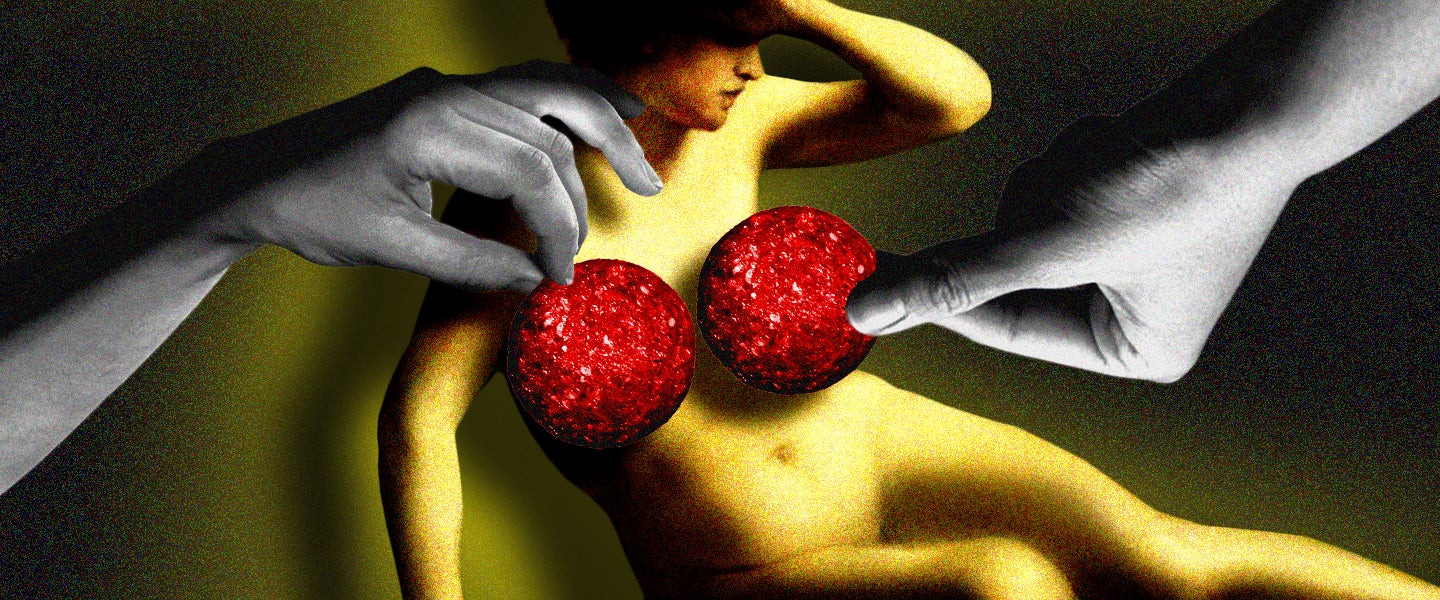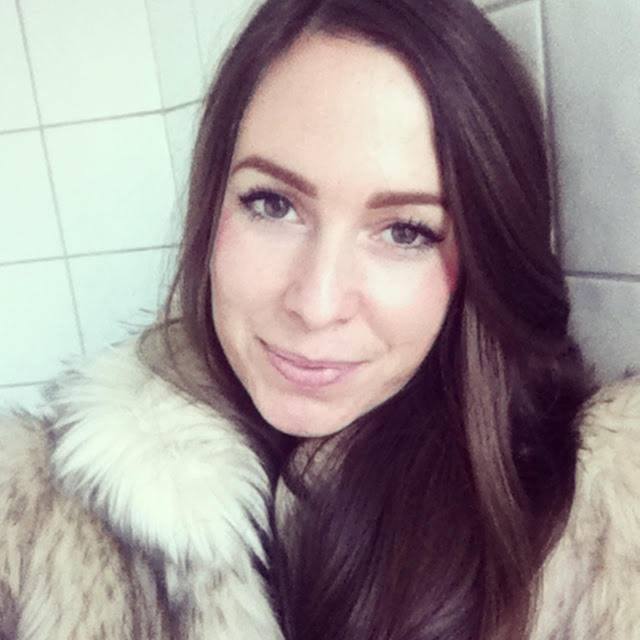When you get Michael Bodkin, a 23-year-old executive assistant from California, on the topic of big areolae, his enthusiasm borders on the spiritual. “Large areolae give the breast more of a ‘face,’” he tells me. “I like to see or feel the large line of the areolae, like a perimeter delineating the nipple as an epicenter of pleasure.” He thinks part of the attraction might be that his own nipples and areolae are so small. “I’m probably naturally attracted to the opposite [of what I have],” he explains. “In general, large areolae feel more imposing and impressive.”
Midway through this year, in the wake of the frenzied discussion about Big Dick Energy, talk of a spinoff lifeforce began to ripple throughout the Twittersphere: that of Big Areola Energy. It was a minor phenomenon compared to its penile counterpart, but like with Big Dick Energy, some people found the idea confusing while others knew exactly what it meant on an intuitive level. Soon enough, Twitter users were linking large areolae with self-assurance, big-hearted loyalty and an honest-to-goodness femininity that women claimed proudly — a round of applause for the display name Areola Grande, by the way — and men openly celebrated.
If her areola big so is her heart and she love hard
— Haitian Kings Don’t Cheat ?? (@LowLifeZoe) October 25, 2018
Big areola energy. pic.twitter.com/nz8lsQSzG4
— Areola Grande (@MafiosoRo) July 16, 2018
“Big areola energy” is something i’m 100% here for
— Aaron (@abake6) July 16, 2018
Max, a 38-year-old architect from California, is one such man. When asked to describe the exact appeal of a generous areolae, he reverts to a childlike sense of wonder. “The contrast in colors is oddly captivating, as is the texture when they’re aroused,” he says. “There’s also the challenge of a large areolae: How much of it can I comfortably fit into my mouth?” Now in his late 30s, Max says that the appeal of big areolae has never worn off. “I don’t imagine I’ll ever stop being fascinated by them and the pleasurable responses they illicit,” he enthuses.
Despite the internet hype about Big Areola Energy and enthusiasm of the men I talked to, appreciation is far from unanimous. Many women whose areolae are bigger than average feel insecure and ashamed; terminology like “pancake nipples” and jokes by boyfriends about Hob Nob biscuits don’t tend to help. 007 Breasts, a website dedicated to documenting “normal” — i.e., not photoshopped or augmented — breasts, has a NSFW gallery containing dozens and dozens of undoctored images with associated commentary from the women pictured. Speaking anonymously, many of them admit to feeling bad about their nipples. “I am self-conscious about my large areolae and the asymmetry of my breasts,” confesses one, while another says, “I am not comfortable with my areolae size, but I am slowly starting to accept my breasts for what they are.”
So what size are areolae supposed to be, and what counts as big? The short answer is that there’s a great degree of variation in areolae size and whatever size they are is whatever size they’re supposed to be, although a study has found the mean diameter to be four centimeters for women. A person’s areolae size is determined largely by genetics — and sometimes reductively linked to race by layman geneticists dwelling in internet forums like Yahoo! Answers — but can change in response to hormones, pregnancy and weight fluctuations. A survey conducted by The Plastic Surgery Group found that 92 percent of their 131 respondents thought a nipple was “too big” if it took up more than 50 percent of the total breast.
Of course, The Plastic Surgery Group, an organization of aesthetic surgeons, is far from an impartial research group, given that the logical endpoint of extreme insecurity about areolae size is surgery — and sure enough, a wholly cosmetic procedure exists to reduce areolae size, costing between $2,000 and $5,000 a pop. Matthew Schulman, a New York City plastic surgeon says he’s seen a 25 percent increase in the number of procedures since last year. “There has always been a desire for smaller areolae,” he tells Allure, “but I think more people are realizing that there is an option for them [to reduce them].”
Obviously, people don’t become insecure about healthy, normal body parts in a vacuum — peer pressure, media depictions of beauty and personal self-esteem all play a role. Not to mention, boys and girls can be cruel about outlying physical features, and large areolae are no exception. “I remember a girl in high school being teased for having ‘pancake nips,’” Bodkin tells me, although even back then it was unclear to him what the problem was. “I remember thinking that didn’t seem like such a bad thing.” Byron, a 34-year-old web designer from Seattle, has also seen unkind comments about big areolae on the internet. “My girlfriend of five years has what I’ve seen called ‘sand dollar’ or ‘pancake’ areolae online,” he tells me. “I’d never encountered nipples like hers before we got together, but now I absolutely love them.”
The explanation for his (and the legion of other big areolae fans’) love is often chalked up to an association with femininity. It’s worth noting, though, that this association may intensify the insecurity of people with large areolae who don’t want to be perceived as feminine. A handful mentioned that large, natural breasts tend to entail big areolae; hence the appeal for Big Boob Guys. But for Troy, a 39-year-old web designer from Chicago, smaller breasts with large areolae were an even more exciting prospect. “My attraction seems most pronounced when areolae are disproportionately large relative to breast size,” he tells me.
In fairness, the fact that men are attracted to all sorts of different body types — and not just the ones that the media or their friends tell them are attractive — is an open secret among anyone who, well, knows more than a handful of men. The general enthusiasm of straight men for breasts is well-documented, so the fact that some men are into large areolae is hardly revelatory. But the kind of open, unabashed love for big areolae that’s taking place on Twitter does feel new, especially in light of the kind of schoolyard jabs they’ve historically elicited.
So why the shift now? Some thanks is surely due to the rise of the body positive movement, which has emboldened men, women and non-binary people to champion bodies that have traditionally received little mainstream kindness: women with stretch marks and cellulite, short kings and everyone else typically left off glossy magazine covers. In the wrong hands that championing can be cringeworthy, condescending and performative — Robbie “I Love My Thick Wife” Tripp is the gold standard here — and the movement’s radical goals need reviving, but the overall trajectory is encouraging.
It’s also true that men as a whole aren’t the scathing titty critics some women imagine them to be, and probably never have been. When push comes to shove, many (most?) guys will appreciate whichever pair is put in front of them, especially if they happen to care deeply about the person they’re attached to. “In my experience, girls tend to be very self-conscious when they have larger areolae, but I don’t see it as a negative at all,” Francis, a 29-year-old IT professional and musician in New York, explains. For him, the appeal is more personal than political. “I’ve realized that my last three girlfriends have all had larger areolae,” he muses, “and I think the attraction is just part of my general fondness for those women.”

